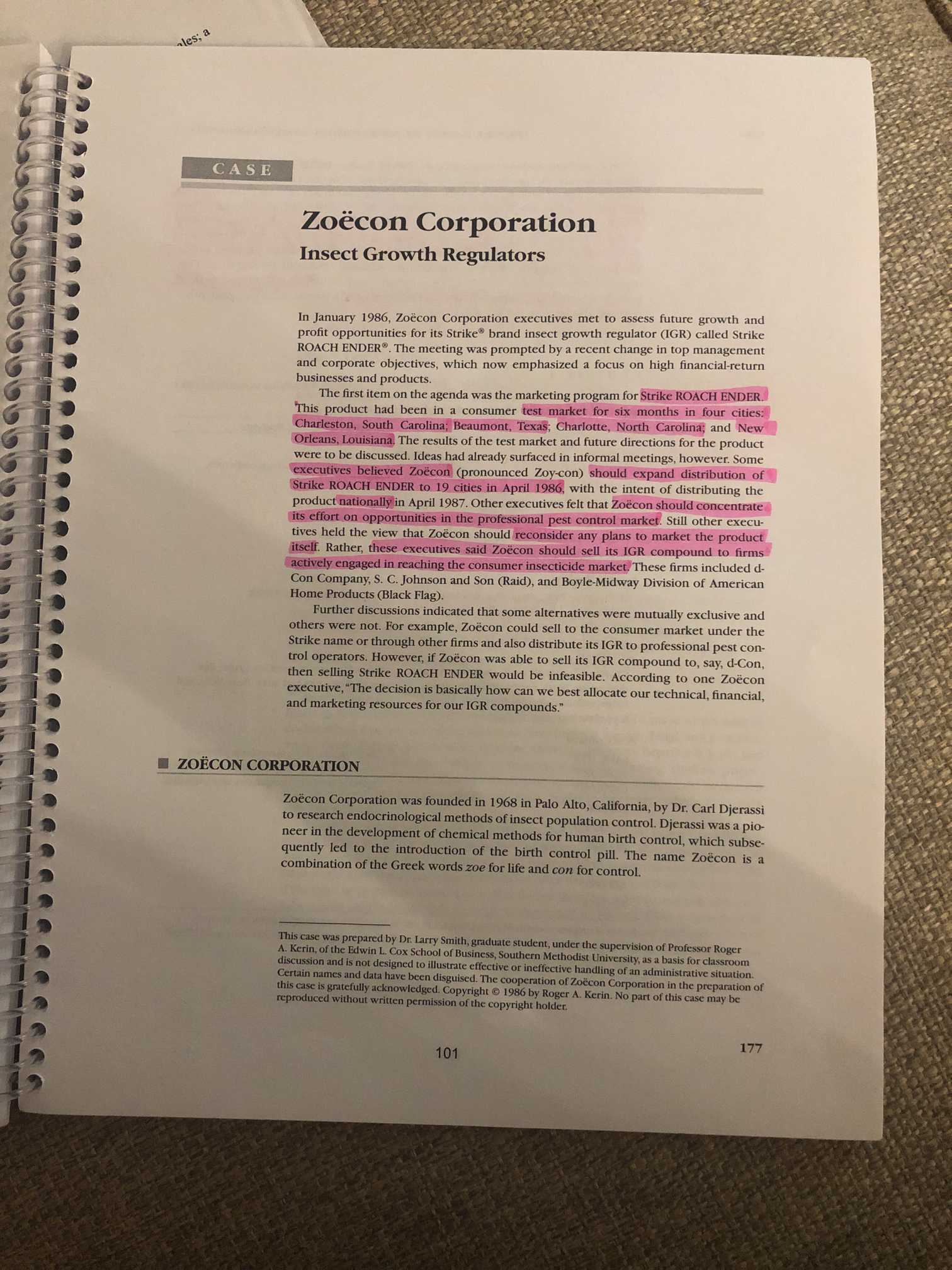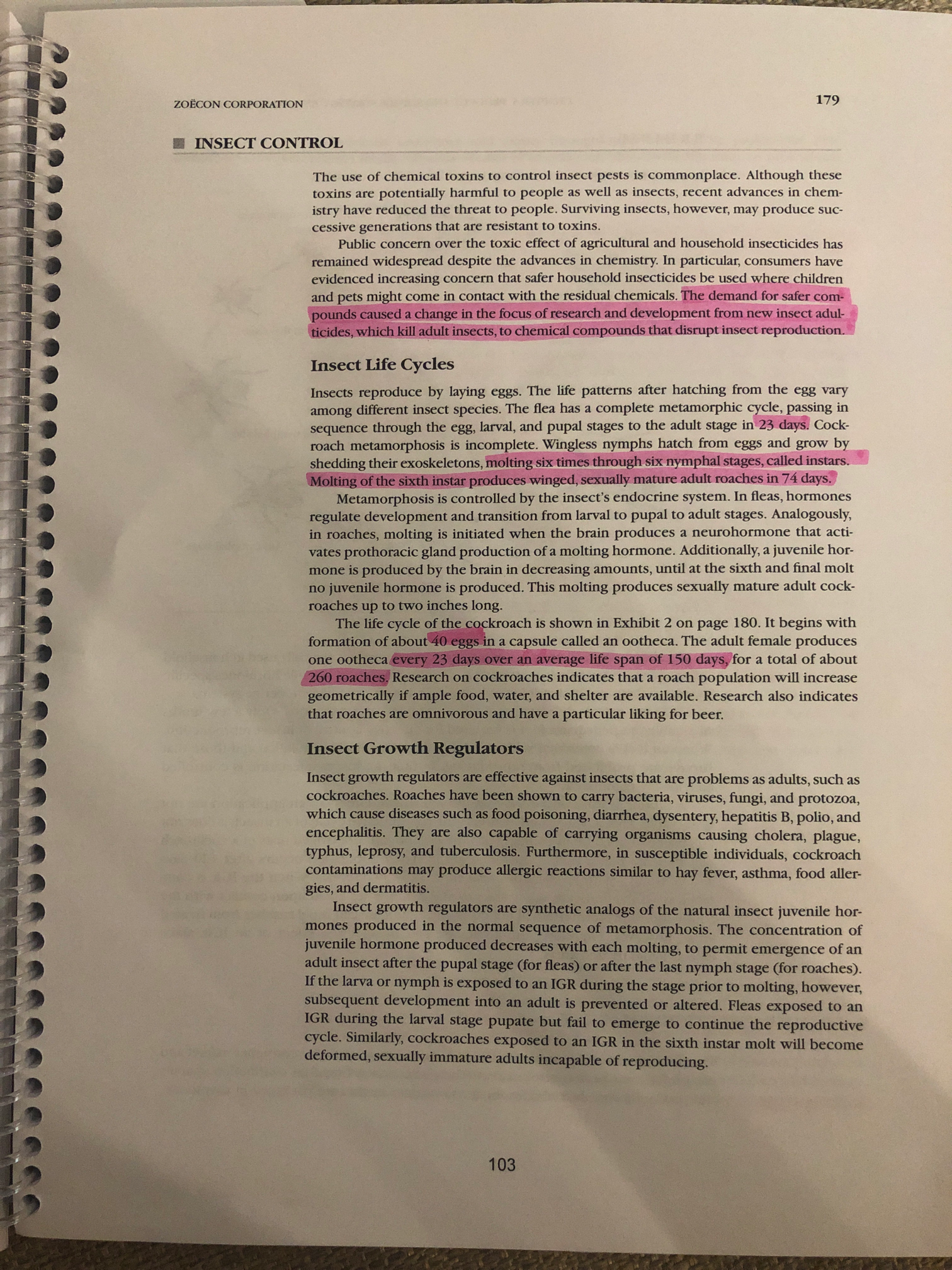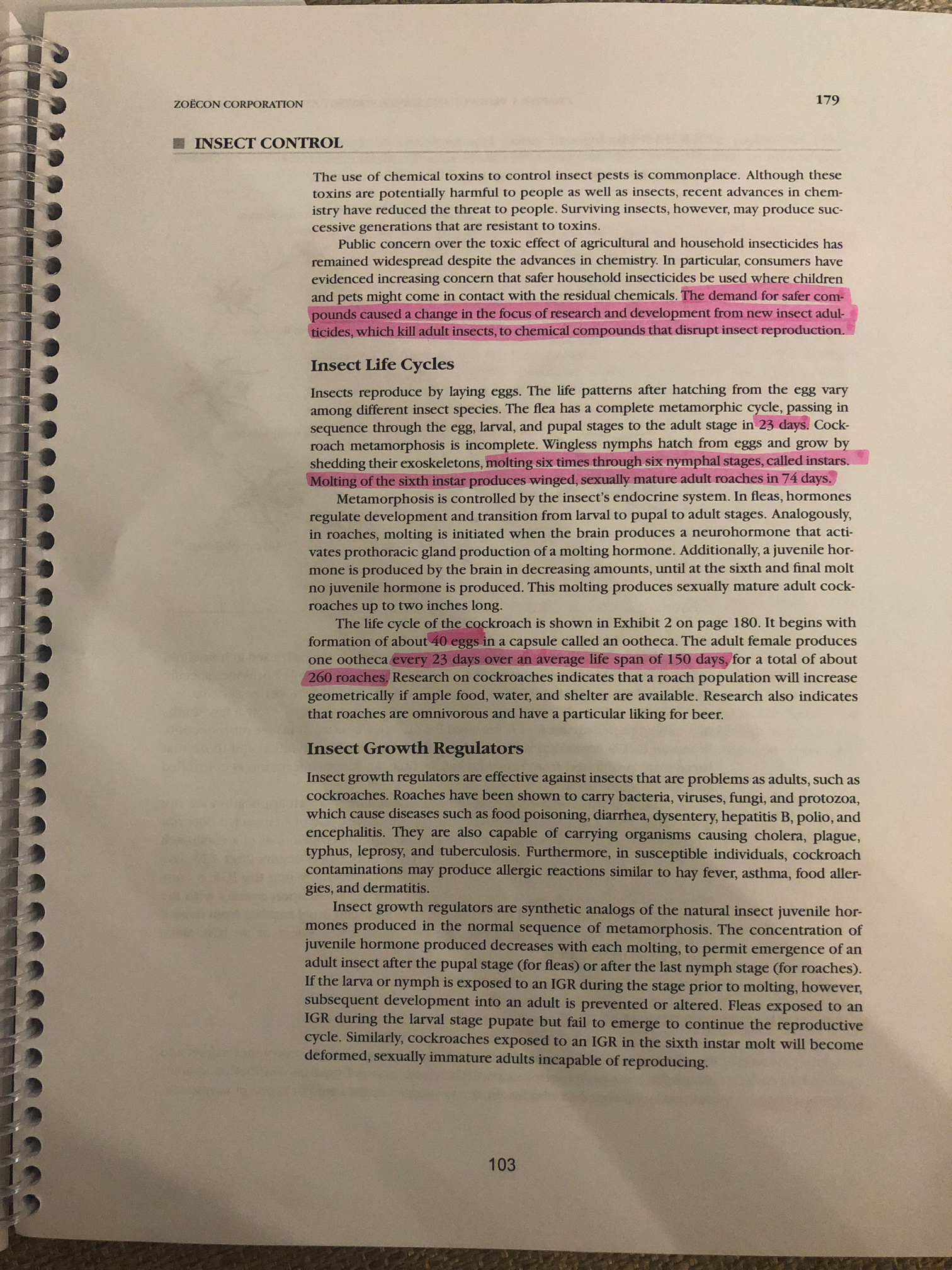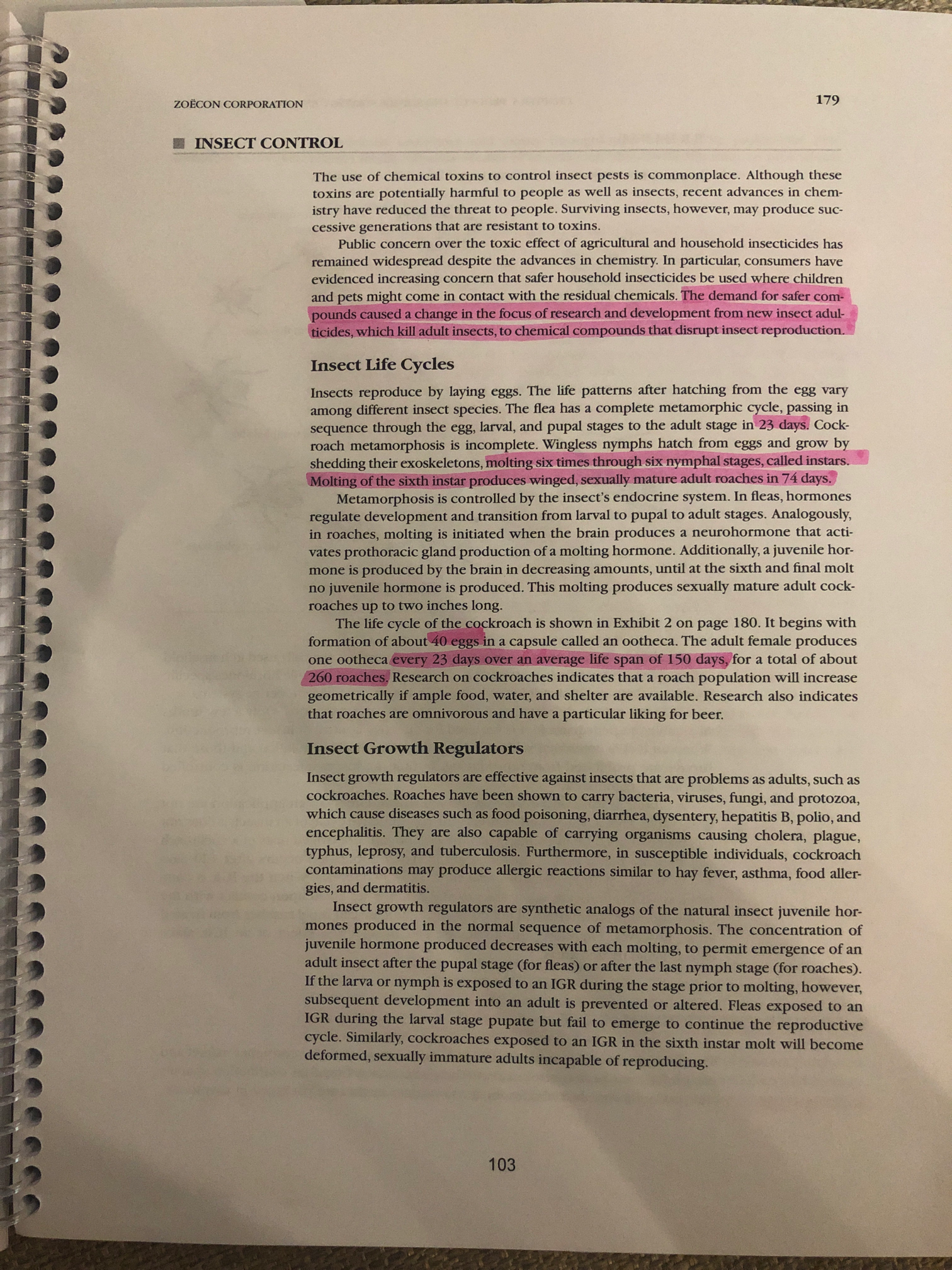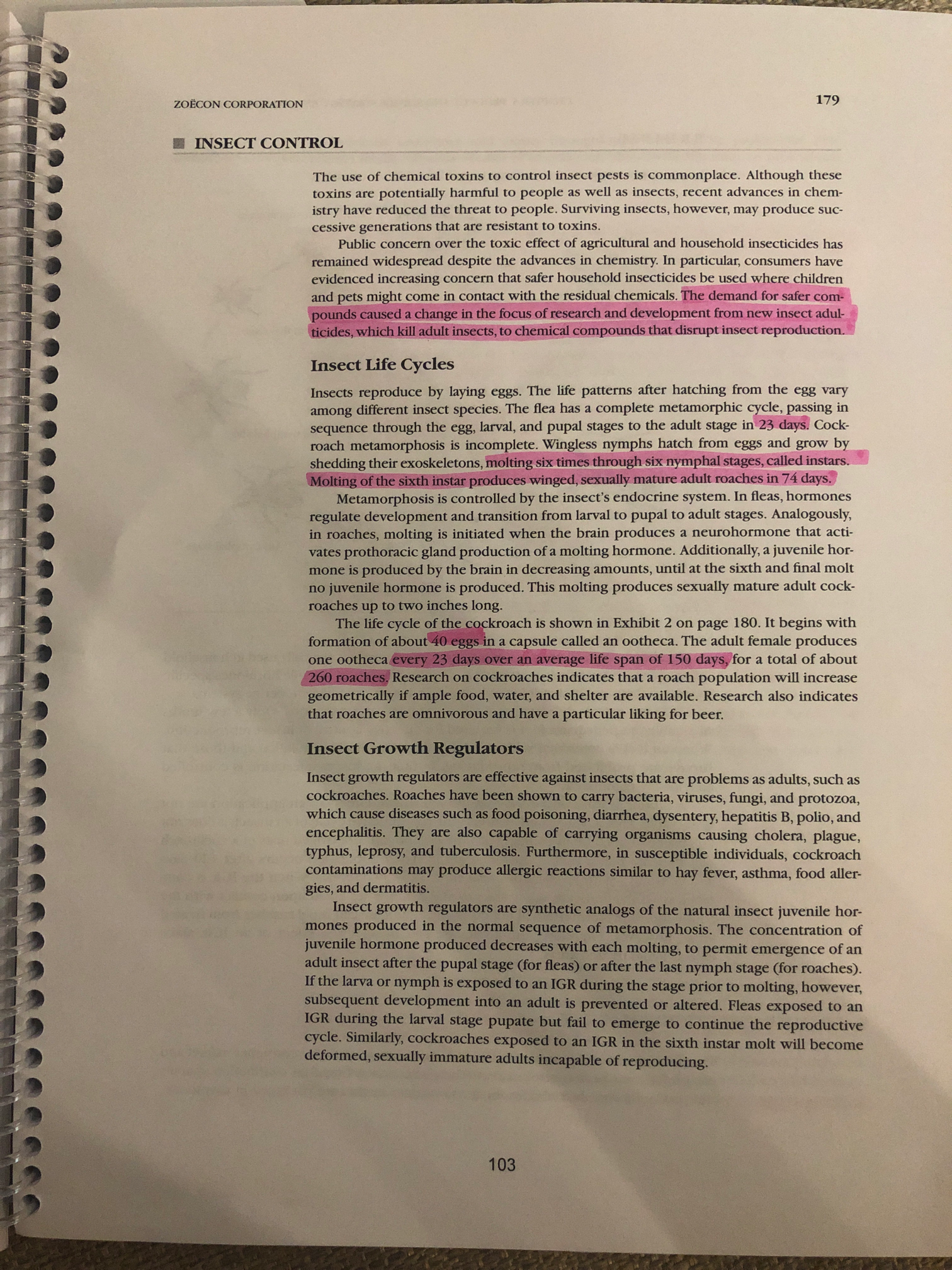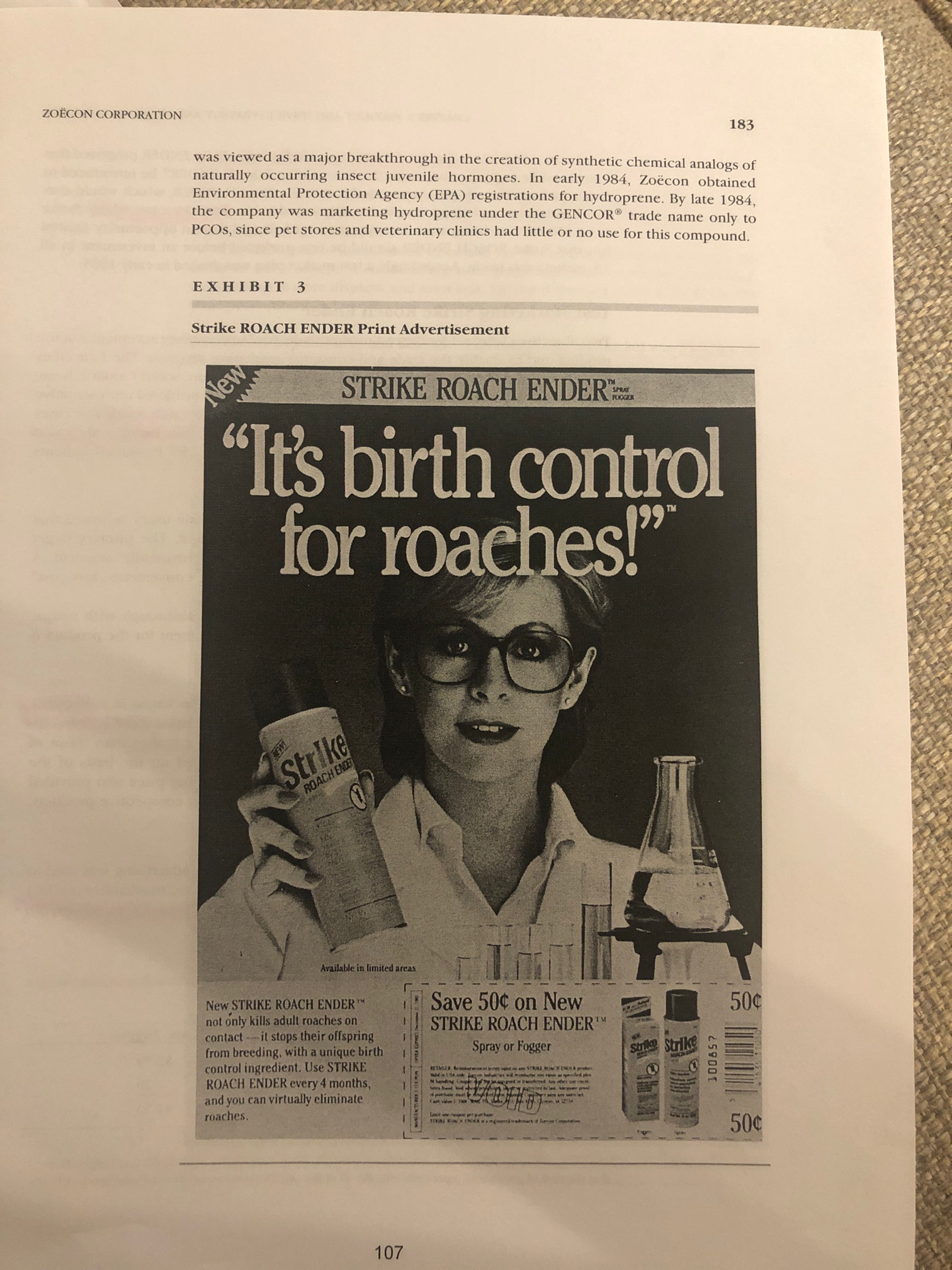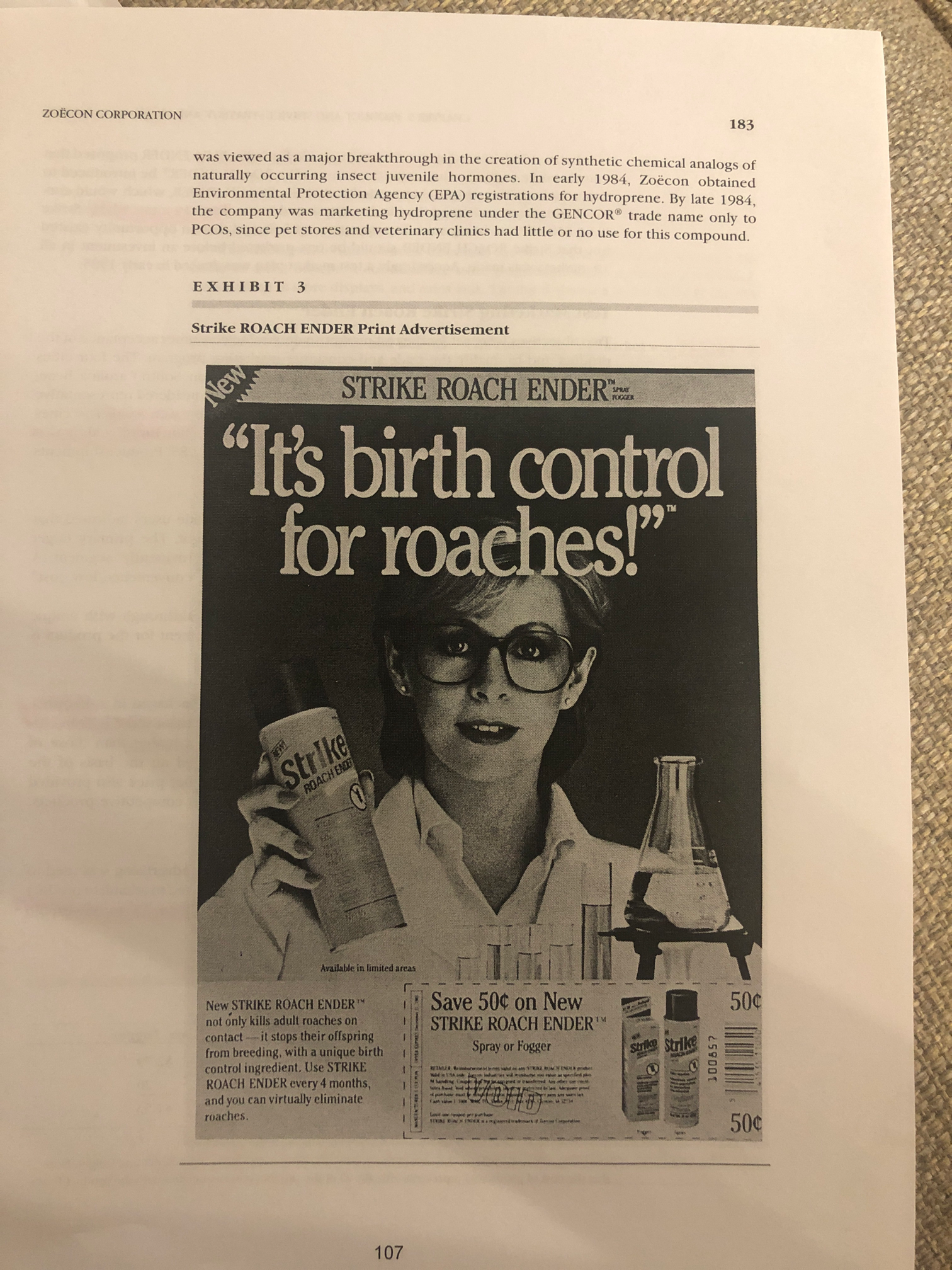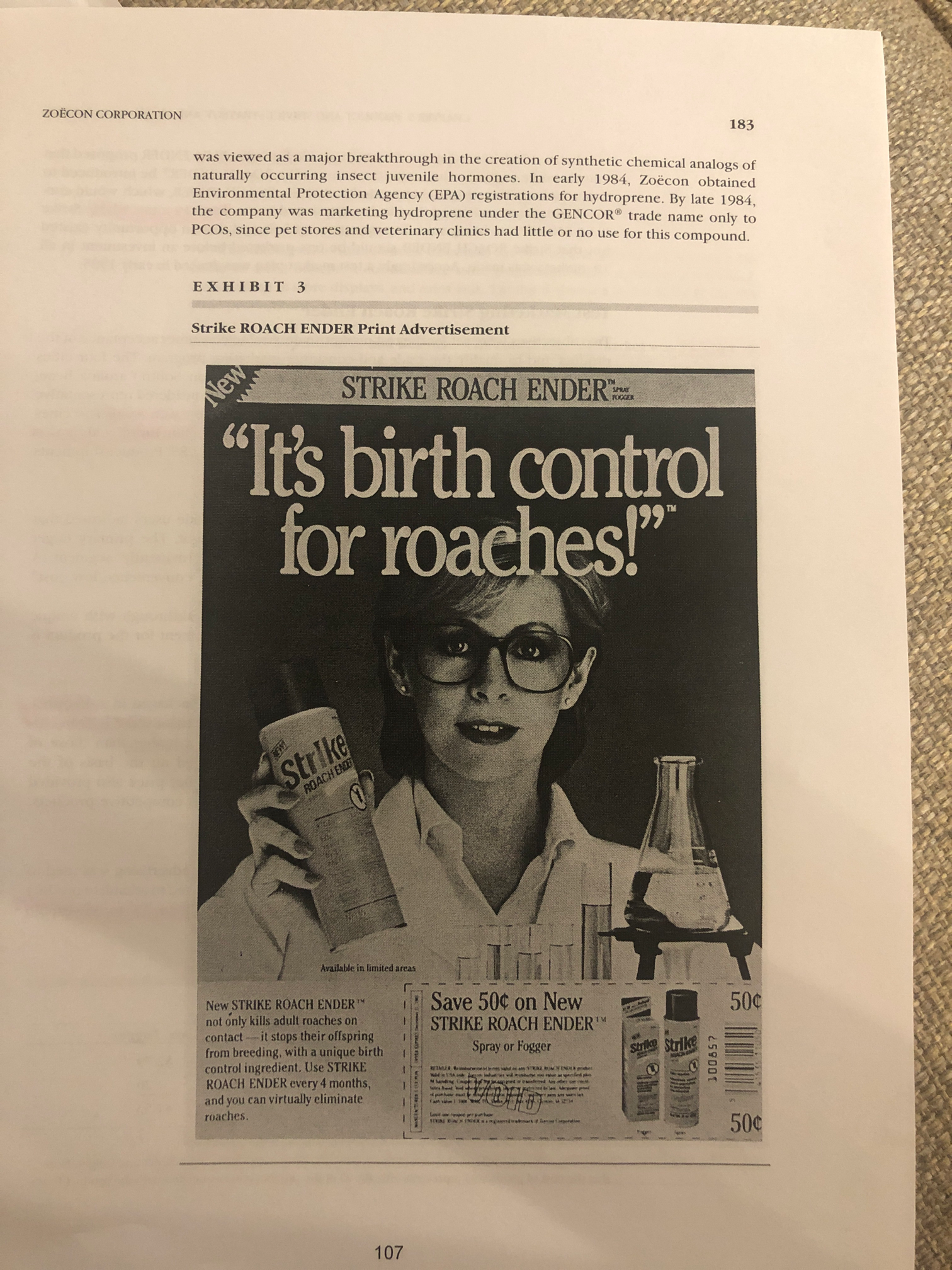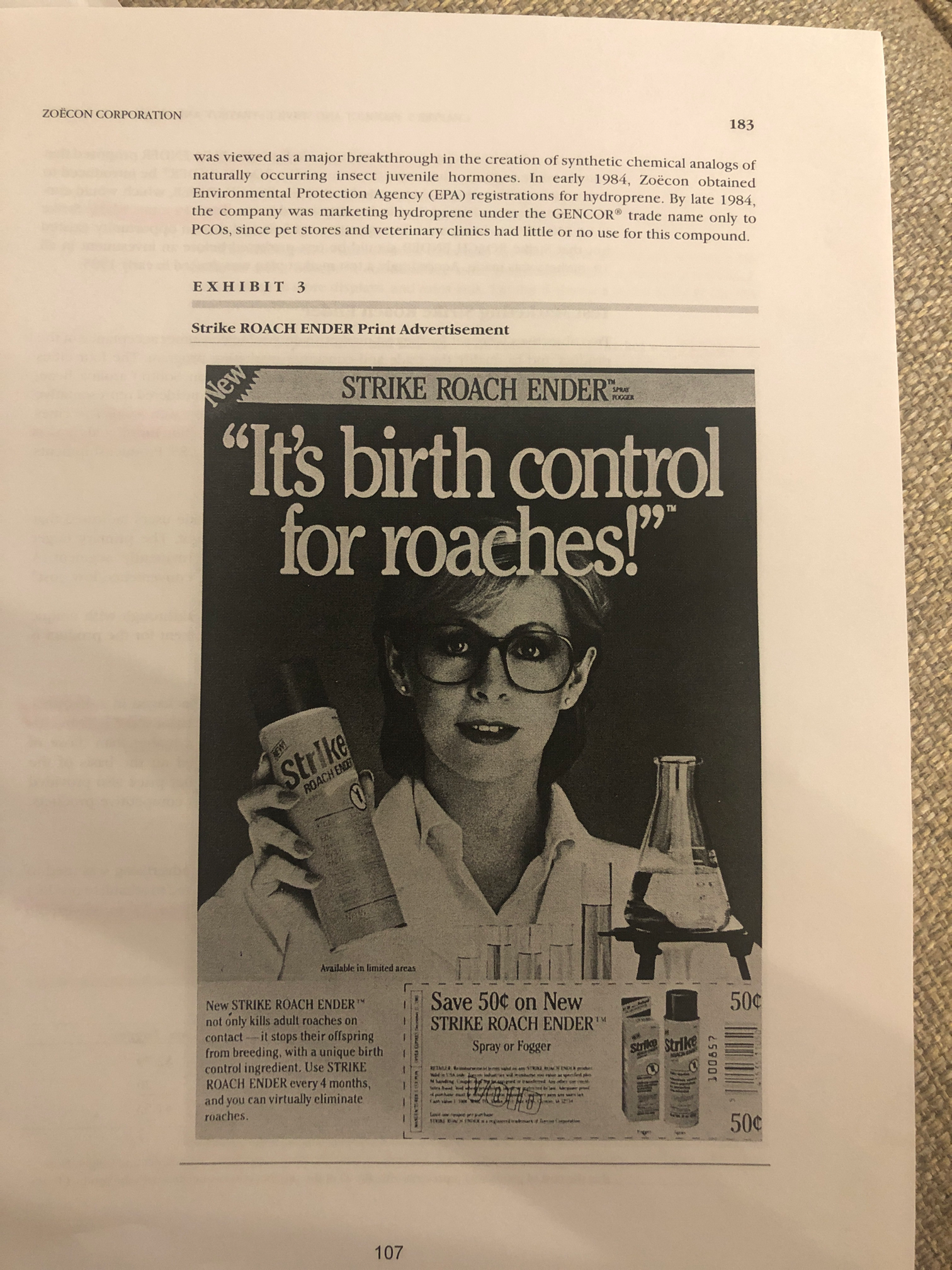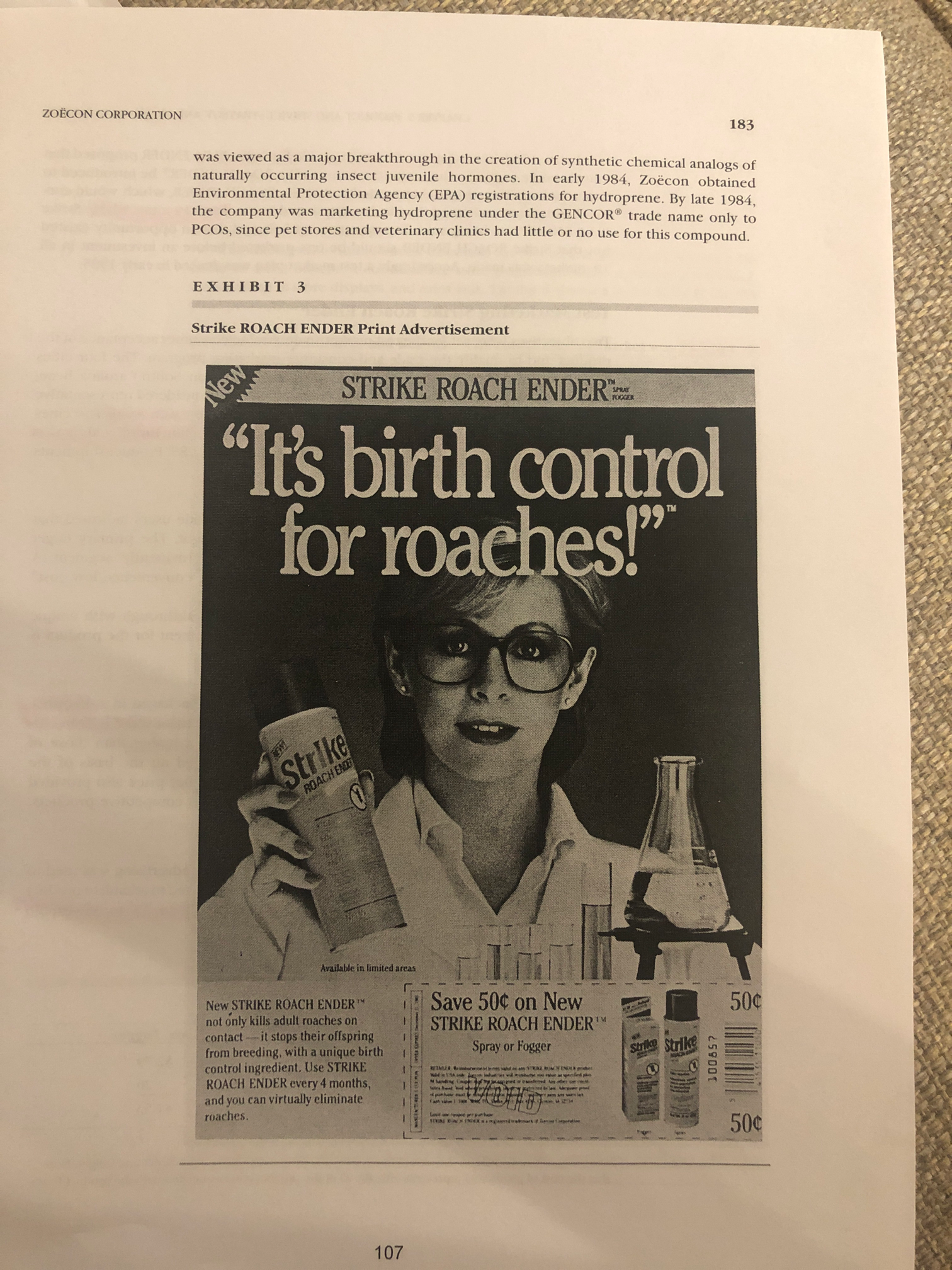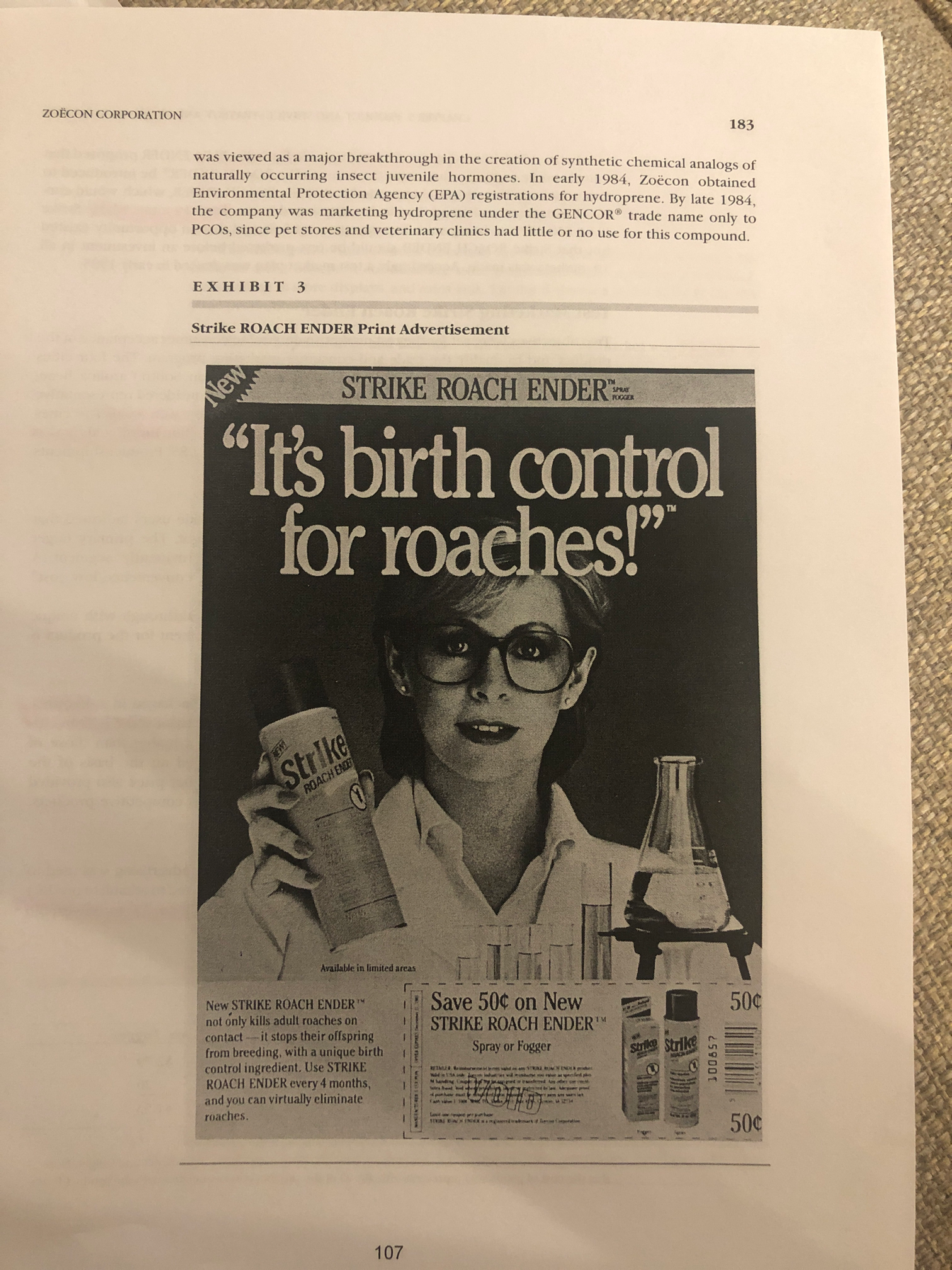Hello! I am doing a case analysis on a case called Zoecon Corporation. I have attached pictures of the case study. I need help doing the calculations for alternative 2 and 3 which I have also attached (the l pic shows alternative 2 and 3 and what calculations need to be done for them.)
please help! Thank you.
ales; a @ OASIS Zoecon Corporation Insect Growth Regulators In January 1986, Zoecon Corporation executives met to assess future growth and profit opportunities for its Strike " brand insect growth regulator ([ GR ) called Strike* ROACH ENDER ". The meeting was prompted by a recent change in top management and corporate objectives , which now emphasized a focus on high financial- return businesses and products . The first item on the agenda was the marketing program for Strike ROACH ENDER .` $60000606 606060 0 This product had been in a consumer test market for six months in four cities : Charleston , South Carolina ; Beaumont , Texas ; Charlotte , North Carolina; and New* Orleans , Louisiana , The results of the test market and future directions for the product* were to be discussed . Ideas had already surfaced in informal meetings , however . Some* executives believed Zoecon ( pronounced Zoy - con ) should expand distribution of Strike ROACH ENDER to 19 cities in April 1986, with the intent of distributing the product nationally in April 1987 . Other executives felt that Zoecon should concentrate* it's effort on opportunities in the professional pest control market . Still other execu - tives held the view that Zoecon should reconsider any plans to market the product* itself . Rather , these executives said Zoecon should sell its IGR compound to firms* actively engaged in reaching the consumer insecticide market . These firms included d - Con Company , S. C. Johnson and Son (Raid ), and Boyle-Midway Division of American Home Products ( Black Flag ) .\\ Further discussions indicated that some alternatives were mutually exclusive and others were not . For example , Zoecon could sell to the consumer market under the Strike name or through other firms and also distribute its IGR to professional pest con - trol operators . However , if Zoecon was able to sell its IGR compound to , say , d- Con , then selling Strike ROACH ENDER would be infeasible . According to one Zoecon executive ," The decision is basically how can we best allocate our technical , financial , and marketing resources for our IGR compounds . " ` ZOECON CORPORATION Zoecon Corporation was founded in 1968 in Palo Alto , California , by Dr. Carl Djerassi to research endocrinologistl methods of insect population control . Djerassi was a pio- neer in the development of chemical methods for human birth control , which subse - quently led to the introduction of the birth control pill . The name Zoecon is a combination of the Greek words zoe for life and con for control . This case was prepared by Dr. Larry Smith , graduate student , under the supervision of Professor Roger A. Kerin , of the Edwin L. Cox SQ `ox School of Business , Southern Methodist University , as a basis for classroom discussion and is not designed to illustrate effective or ineffective handling of an administrative situation Certain names and data have been disguised . The cooperation of Zoecon Corporation in the preparation of this case is gratefully acknowledged . Copyright @ 1986 by Roger A. Kerin . No part of this case may be reproduced without written permission of the copyright holder .\\ 101 177ZOECON CORPORATION 179 I INSECT CONTROL The use of chemical toxins to control insect pests is commonplace . Although these toxins are potentially harmful to people as well as insects , recent advances in chem - istry have reduced the threat to people . Surviving insects , however , may produce suc - cessive generations that are resistant to toxins .\\ Public concern over the toxic effect of agricultural and household insecticides has remained widespread despite the advances in chemistry . In particular , consumers have evidenced increasing concern that safer household insecticides be used where children and pets might come in contact with the residual chemicals . The demand for safer com - pounds caused a change in the focus of research and development from new insect adul - Licides , which kill adult insects , to chemical compounds that disrupt insect reproduction ." Insect Life Cycles Insects reproduce by laying eggs . The life patterns after hatching from the egg vary among different insect species . The flea has a complete metamorphic cycle , passing in sequence through the egg, larval , and pupal stages to the adult stage in 23 days. Cock- roach metamorphosis is incomplete . Wingless nymphs hatch from eggs and grow by shedding their exoskeletons , molting six times through six nymphal stages , called instars .\\ Molting of the sixth instar produces winged , sexually mature adult roaches in 74 days ." Metamorphosis is controlled by the insect's endocrine system . In fleas , hormones regulate development and transition from larval to pupal to adult stages . Analogously , in roaches , molting is initiated when the brain produces a neurohormone that acti - vates prothoracic gland production of a molting hormone . Additionally , a juvenile hor - mone is produced by the brain in decreasing amounts , until at the sixth and final molt no juvenile hormone is produced . This molting produces sexually mature adult cock - roaches up to two inches long .\\ The life cycle of the cockroach is shown in Exhibit 2 on page 180 . It begins with formation of about 40 eggs in a capsule called an ootheca . The adult female produces one ootheca every 23 days over an average life span of 150 days , for a total of about 260 roaches . Research on cockroaches indicates that a roach population will increase geometrically if ample food , water , and shelter are available . Research also indicates that roaches are omnivorous and have a particular liking for beer .\\ Insect Growth Regulators Insect growth regulators are effective against insects that are problems as adults , such as cockroaches . Roaches have been shown to carry bacteria , viruses , fungi , and protozoa , which cause diseases such as food poisoning , diarrhea , dysentery , hepatitis B , polio , and encephalitis . They are also capable of carrying organisms causing cholera , plague , typhus , leprosy , and tuberculosis . Furthermore , in susceptible individuals , cockroach contaminations may produce allergic reactions similar to hay fever , asthma , food aller - gies , and dermatitis .* Insect growth regulators are synthetic analogs of the natural insect juvenile hor - mones produced in the normal sequence of metamorphosis . The concentration of juvenile hormone produced decreases with each molting , to permit emergence of an adult insect after the pupal stage ( for fleas ) or after the last nymph stage ( for roaches ). If the larva or nymph is exposed to an IGR during the stage prior to molting , however , subsequent development into an adult is prevented or altered . Fleas exposed to an IGR during the larval stage pupate but fail to emerge to continue the reproductive cycle . Similarly , cockroaches exposed to an IGR in the sixth instar molt will become deformed , sexually immature adults incapable of reproducing . 103ZOECON CORPORATION 179 I INSECT CONTROL The use of chemical toxins to control insect pests is commonplace . Although these toxins are potentially harmful to people as well as insects , recent advances in chem - istry have reduced the threat to people . Surviving insects , however , may produce suc - cessive generations that are resistant to toxins .\\ Public concern over the toxic effect of agricultural and household insecticides has remained widespread despite the advances in chemistry . In particular , consumers have evidenced increasing concern that safer household insecticides be used where children and pets might come in contact with the residual chemicals . The demand for safer com - pounds caused a change in the focus of research and development from new insect adul - Licides , which kill adult insects , to chemical compounds that disrupt insect reproduction ." Insect Life Cycles Insects reproduce by laying eggs . The life patterns after hatching from the egg vary among different insect species . The flea has a complete metamorphic cycle , passing in sequence through the egg, larval , and pupal stages to the adult stage in 23 days. Cock- roach metamorphosis is incomplete . Wingless nymphs hatch from eggs and grow by shedding their exoskeletons , molting six times through six nymphal stages , called instars .\\ Molting of the sixth instar produces winged , sexually mature adult roaches in 74 days ." Metamorphosis is controlled by the insect's endocrine system . In fleas , hormones regulate development and transition from larval to pupal to adult stages . Analogously , in roaches , molting is initiated when the brain produces a neurohormone that acti - vates prothoracic gland production of a molting hormone . Additionally , a juvenile hor - mone is produced by the brain in decreasing amounts , until at the sixth and final molt no juvenile hormone is produced . This molting produces sexually mature adult cock - roaches up to two inches long .\\ The life cycle of the cockroach is shown in Exhibit 2 on page 180 . It begins with formation of about 40 eggs in a capsule called an ootheca . The adult female produces one ootheca every 23 days over an average life span of 150 days , for a total of about 260 roaches . Research on cockroaches indicates that a roach population will increase geometrically if ample food , water , and shelter are available . Research also indicates that roaches are omnivorous and have a particular liking for beer .\\ Insect Growth Regulators Insect growth regulators are effective against insects that are problems as adults , such as cockroaches . Roaches have been shown to carry bacteria , viruses , fungi , and protozoa , which cause diseases such as food poisoning , diarrhea , dysentery , hepatitis B , polio , and encephalitis . They are also capable of carrying organisms causing cholera , plague , typhus , leprosy , and tuberculosis . Furthermore , in susceptible individuals , cockroach contaminations may produce allergic reactions similar to hay fever , asthma , food aller - gies , and dermatitis .* Insect growth regulators are synthetic analogs of the natural insect juvenile hor - mones produced in the normal sequence of metamorphosis . The concentration of juvenile hormone produced decreases with each molting , to permit emergence of an adult insect after the pupal stage ( for fleas ) or after the last nymph stage ( for roaches ). If the larva or nymph is exposed to an IGR during the stage prior to molting , however , subsequent development into an adult is prevented or altered . Fleas exposed to an IGR during the larval stage pupate but fail to emerge to continue the reproductive cycle . Similarly , cockroaches exposed to an IGR in the sixth instar molt will become deformed , sexually immature adults incapable of reproducing . 103ZOECON CORPORATION 179 I INSECT CONTROL The use of chemical toxins to control insect pests is commonplace . Although these toxins are potentially harmful to people as well as insects , recent advances in chem - istry have reduced the threat to people . Surviving insects , however , may produce suc - cessive generations that are resistant to toxins .\\ Public concern over the toxic effect of agricultural and household insecticides has remained widespread despite the advances in chemistry . In particular , consumers have evidenced increasing concern that safer household insecticides be used where children and pets might come in contact with the residual chemicals . The demand for safer com - pounds caused a change in the focus of research and development from new insect adul - Licides , which kill adult insects , to chemical compounds that disrupt insect reproduction ." Insect Life Cycles Insects reproduce by laying eggs . The life patterns after hatching from the egg vary among different insect species . The flea has a complete metamorphic cycle , passing in sequence through the egg, larval , and pupal stages to the adult stage in 23 days. Cock- roach metamorphosis is incomplete . Wingless nymphs hatch from eggs and grow by shedding their exoskeletons , molting six times through six nymphal stages , called instars .\\ Molting of the sixth instar produces winged , sexually mature adult roaches in 74 days ." Metamorphosis is controlled by the insect's endocrine system . In fleas , hormones regulate development and transition from larval to pupal to adult stages . Analogously , in roaches , molting is initiated when the brain produces a neurohormone that acti - vates prothoracic gland production of a molting hormone . Additionally , a juvenile hor - mone is produced by the brain in decreasing amounts , until at the sixth and final molt no juvenile hormone is produced . This molting produces sexually mature adult cock - roaches up to two inches long .\\ The life cycle of the cockroach is shown in Exhibit 2 on page 180 . It begins with formation of about 40 eggs in a capsule called an ootheca . The adult female produces one ootheca every 23 days over an average life span of 150 days , for a total of about 260 roaches . Research on cockroaches indicates that a roach population will increase geometrically if ample food , water , and shelter are available . Research also indicates that roaches are omnivorous and have a particular liking for beer .\\ Insect Growth Regulators Insect growth regulators are effective against insects that are problems as adults , such as cockroaches . Roaches have been shown to carry bacteria , viruses , fungi , and protozoa , which cause diseases such as food poisoning , diarrhea , dysentery , hepatitis B , polio , and encephalitis . They are also capable of carrying organisms causing cholera , plague , typhus , leprosy , and tuberculosis . Furthermore , in susceptible individuals , cockroach contaminations may produce allergic reactions similar to hay fever , asthma , food aller - gies , and dermatitis .* Insect growth regulators are synthetic analogs of the natural insect juvenile hor - mones produced in the normal sequence of metamorphosis . The concentration of juvenile hormone produced decreases with each molting , to permit emergence of an adult insect after the pupal stage ( for fleas ) or after the last nymph stage ( for roaches ). If the larva or nymph is exposed to an IGR during the stage prior to molting , however , subsequent development into an adult is prevented or altered . Fleas exposed to an IGR during the larval stage pupate but fail to emerge to continue the reproductive cycle . Similarly , cockroaches exposed to an IGR in the sixth instar molt will become deformed , sexually immature adults incapable of reproducing . 103ZOECON CORPORATION 179 I INSECT CONTROL The use of chemical toxins to control insect pests is commonplace . Although these toxins are potentially harmful to people as well as insects , recent advances in chem - istry have reduced the threat to people . Surviving insects , however , may produce suc - cessive generations that are resistant to toxins .\\ Public concern over the toxic effect of agricultural and household insecticides has remained widespread despite the advances in chemistry . In particular , consumers have evidenced increasing concern that safer household insecticides be used where children and pets might come in contact with the residual chemicals . The demand for safer com - pounds caused a change in the focus of research and development from new insect adul - Licides , which kill adult insects , to chemical compounds that disrupt insect reproduction ." Insect Life Cycles Insects reproduce by laying eggs . The life patterns after hatching from the egg vary among different insect species . The flea has a complete metamorphic cycle , passing in sequence through the egg, larval , and pupal stages to the adult stage in 23 days. Cock- roach metamorphosis is incomplete . Wingless nymphs hatch from eggs and grow by shedding their exoskeletons , molting six times through six nymphal stages , called instars .\\ Molting of the sixth instar produces winged , sexually mature adult roaches in 74 days ." Metamorphosis is controlled by the insect's endocrine system . In fleas , hormones regulate development and transition from larval to pupal to adult stages . Analogously , in roaches , molting is initiated when the brain produces a neurohormone that acti - vates prothoracic gland production of a molting hormone . Additionally , a juvenile hor - mone is produced by the brain in decreasing amounts , until at the sixth and final molt no juvenile hormone is produced . This molting produces sexually mature adult cock - roaches up to two inches long .\\ The life cycle of the cockroach is shown in Exhibit 2 on page 180 . It begins with formation of about 40 eggs in a capsule called an ootheca . The adult female produces one ootheca every 23 days over an average life span of 150 days , for a total of about 260 roaches . Research on cockroaches indicates that a roach population will increase geometrically if ample food , water , and shelter are available . Research also indicates that roaches are omnivorous and have a particular liking for beer .\\ Insect Growth Regulators Insect growth regulators are effective against insects that are problems as adults , such as cockroaches . Roaches have been shown to carry bacteria , viruses , fungi , and protozoa , which cause diseases such as food poisoning , diarrhea , dysentery , hepatitis B , polio , and encephalitis . They are also capable of carrying organisms causing cholera , plague , typhus , leprosy , and tuberculosis . Furthermore , in susceptible individuals , cockroach contaminations may produce allergic reactions similar to hay fever , asthma , food aller - gies , and dermatitis .* Insect growth regulators are synthetic analogs of the natural insect juvenile hor - mones produced in the normal sequence of metamorphosis . The concentration of juvenile hormone produced decreases with each molting , to permit emergence of an adult insect after the pupal stage ( for fleas ) or after the last nymph stage ( for roaches ). If the larva or nymph is exposed to an IGR during the stage prior to molting , however , subsequent development into an adult is prevented or altered . Fleas exposed to an IGR during the larval stage pupate but fail to emerge to continue the reproductive cycle . Similarly , cockroaches exposed to an IGR in the sixth instar molt will become deformed , sexually immature adults incapable of reproducing . 103ZOECON CORPORATION 183 was viewed as a major breakthrough in the creation of synthetic chemical analogs of naturally occurring insect juvenile hormones. In early 1984, Zoecon obtained Environmental Protection Agency (EPA) registrations for hydroprene. By late 1984, the company was marketing hydroprene under the GENCOR@ trade name only to PCOs, since pet stores and veterinary clinics had little or no use for this compound. EXHIBIT 3 Strike ROACH ENDER Print Advertisement New STRIKE ROACH ENDER"= "It's birth control for roaches!' Strike ROACH ENDER Available in limited areas New STRIKE ROACH ENDER" Save 50c on New 500 not only kills adult roaches on contact - it stops their offspring STRIKE ROACH ENDER" from breeding, with a unique birth Spray or Fogger Strike 259001 control ingredient. Use STRIKE ROACH ENDER every 4 months and you can virtually eliminate roaches. 500 107ZOECON CORPORATION 183 was viewed as a major breakthrough in the creation of synthetic chemical analogs of naturally occurring insect juvenile hormones. In early 1984, Zoecon obtained Environmental Protection Agency (EPA) registrations for hydroprene. By late 1984, the company was marketing hydroprene under the GENCOR@ trade name only to PCOs, since pet stores and veterinary clinics had little or no use for this compound. EXHIBIT 3 Strike ROACH ENDER Print Advertisement New STRIKE ROACH ENDER"= "It's birth control for roaches!' Strike ROACH ENDER Available in limited areas New STRIKE ROACH ENDER" Save 50c on New 500 not only kills adult roaches on contact - it stops their offspring STRIKE ROACH ENDER" from breeding, with a unique birth Spray or Fogger Strike 259001 control ingredient. Use STRIKE ROACH ENDER every 4 months and you can virtually eliminate roaches. 500 107ZOECON CORPORATION 183 was viewed as a major breakthrough in the creation of synthetic chemical analogs of naturally occurring insect juvenile hormones. In early 1984, Zoecon obtained Environmental Protection Agency (EPA) registrations for hydroprene. By late 1984, the company was marketing hydroprene under the GENCOR@ trade name only to PCOs, since pet stores and veterinary clinics had little or no use for this compound. EXHIBIT 3 Strike ROACH ENDER Print Advertisement New STRIKE ROACH ENDER"= "It's birth control for roaches!' Strike ROACH ENDER Available in limited areas New STRIKE ROACH ENDER" Save 50c on New 500 not only kills adult roaches on contact - it stops their offspring STRIKE ROACH ENDER" from breeding, with a unique birth Spray or Fogger Strike 259001 control ingredient. Use STRIKE ROACH ENDER every 4 months and you can virtually eliminate roaches. 500 107ZOECON CORPORATION 183 was viewed as a major breakthrough in the creation of synthetic chemical analogs of naturally occurring insect juvenile hormones. In early 1984, Zoecon obtained Environmental Protection Agency (EPA) registrations for hydroprene. By late 1984, the company was marketing hydroprene under the GENCOR@ trade name only to PCOs, since pet stores and veterinary clinics had little or no use for this compound. EXHIBIT 3 Strike ROACH ENDER Print Advertisement New STRIKE ROACH ENDER"= "It's birth control for roaches!' Strike ROACH ENDER Available in limited areas New STRIKE ROACH ENDER" Save 50c on New 500 not only kills adult roaches on contact - it stops their offspring STRIKE ROACH ENDER" from breeding, with a unique birth Spray or Fogger Strike 259001 control ingredient. Use STRIKE ROACH ENDER every 4 months and you can virtually eliminate roaches. 500 107ZOECON CORPORATION 183 was viewed as a major breakthrough in the creation of synthetic chemical analogs of naturally occurring insect juvenile hormones. In early 1984, Zoecon obtained Environmental Protection Agency (EPA) registrations for hydroprene. By late 1984, the company was marketing hydroprene under the GENCOR@ trade name only to PCOs, since pet stores and veterinary clinics had little or no use for this compound. EXHIBIT 3 Strike ROACH ENDER Print Advertisement New STRIKE ROACH ENDER"= "It's birth control for roaches!' Strike ROACH ENDER Available in limited areas New STRIKE ROACH ENDER" Save 50c on New 500 not only kills adult roaches on contact - it stops their offspring STRIKE ROACH ENDER" from breeding, with a unique birth Spray or Fogger Strike 259001 control ingredient. Use STRIKE ROACH ENDER every 4 months and you can virtually eliminate roaches. 500 107ZOECON CORPORATION 183 was viewed as a major breakthrough in the creation of synthetic chemical analogs of naturally occurring insect juvenile hormones. In early 1984, Zoecon obtained Environmental Protection Agency (EPA) registrations for hydroprene. By late 1984, the company was marketing hydroprene under the GENCOR@ trade name only to PCOs, since pet stores and veterinary clinics had little or no use for this compound. EXHIBIT 3 Strike ROACH ENDER Print Advertisement New STRIKE ROACH ENDER"= "It's birth control for roaches!' Strike ROACH ENDER Available in limited areas New STRIKE ROACH ENDER" Save 50c on New 500 not only kills adult roaches on contact - it stops their offspring STRIKE ROACH ENDER" from breeding, with a unique birth Spray or Fogger Strike 259001 control ingredient. Use STRIKE ROACH ENDER every 4 months and you can virtually eliminate roaches. 500 107
